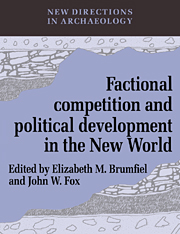Book contents
- Frontmatter
- Contents
- List of figures
- List of tables
- List of contributors
- Preface
- PART I INTRODUCTION
- PART II CHIEFDOMS
- PART III STATES
- 7 Ethnicity and political control in a complex society: the Tarascan state of prehispanic Mexico
- 8 Ethnic groups and political development in ancient Mexico
- 9 Factional divisions within the Aztec (Colhua) royal family
- 10 Alliance and intervention in Aztec imperial expansion
- 11 Political factions in the transition from Classic to Postclassic in the Mixteca Alta
- 12 Internal subdivisions of communities in the prehispanic Valley of Oaxaca
- 13 Cycles of conflict: political factionalism in the Maya Lowlands
- 14 Political cosmology among the Quiché Maya
- 15 Factions and political development in the central Andes
- PART IV DISCUSSIONS
- Bibliography
- Index
14 - Political cosmology among the Quiché Maya
Published online by Cambridge University Press: 18 December 2009
- Frontmatter
- Contents
- List of figures
- List of tables
- List of contributors
- Preface
- PART I INTRODUCTION
- PART II CHIEFDOMS
- PART III STATES
- 7 Ethnicity and political control in a complex society: the Tarascan state of prehispanic Mexico
- 8 Ethnic groups and political development in ancient Mexico
- 9 Factional divisions within the Aztec (Colhua) royal family
- 10 Alliance and intervention in Aztec imperial expansion
- 11 Political factions in the transition from Classic to Postclassic in the Mixteca Alta
- 12 Internal subdivisions of communities in the prehispanic Valley of Oaxaca
- 13 Cycles of conflict: political factionalism in the Maya Lowlands
- 14 Political cosmology among the Quiché Maya
- 15 Factions and political development in the central Andes
- PART IV DISCUSSIONS
- Bibliography
- Index
Summary
Introduction: competition among segmentary lineages
The Lowland Mayan ancestors of the Quiché entered the Guatemalan Highlands at the close of the Classic period (AD late 800s), and confederated during the Early Postclassic (AD 1100s). Factionalism permeated these political fields. This chapter examines the political and ideological transformations that resulted from competition (1) between the contending Quiché groups as well as (2) between the Quiché and the peoples they subjugated. In both contexts, the Venusian calendar for lineage identities and for timing battles intermeshed with the 260-day calendar for personal prognostication (e.g. Popol Vuh 1971:243–4); the solar calendar bound competing lineages within a state. The inter-digitating of the three calendars furnished an ideological calculus for spacing the contentious descent groups and for allotting political prerogatives. In essence, as celestial bodies traveled through various calendrical repetitions, the social actors vied for identities and privileges that mirrored cosmic orderings. The incessant competition for prestige and political leverage provided a dynamic propelling transformation of egalitarian alliances to successively more coercive and hierarchical social exchange.
The chain of political contests from ethnohistory correlates with successive transformations in settlement patterns. That is, power relations are reflected in site plans where specific architecture of known lineages is keyed to specific solar, lunar, planetary, and stellar positions and clusters, especially solstices, equinoxes, conjunctions, and helical risings/settings.
Numerology and political calculus
To summarize the Popol Vuh (1971:3–19), in the night sky Orion was the Creator of the cosmic order – The Heart of Heaven – who wedded the celestial beings (constellations) with the Green Feathered Serpent (K'ucumatz).
- Type
- Chapter
- Information
- Factional Competition and Political Development in the New World , pp. 158 - 170Publisher: Cambridge University PressPrint publication year: 1994
- 4
- Cited by



